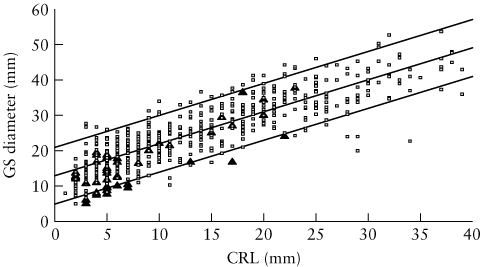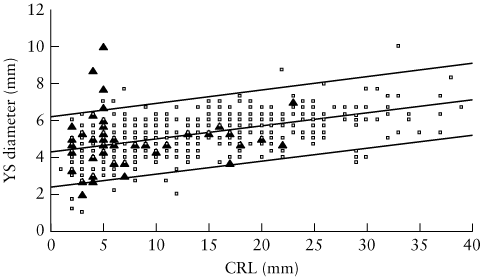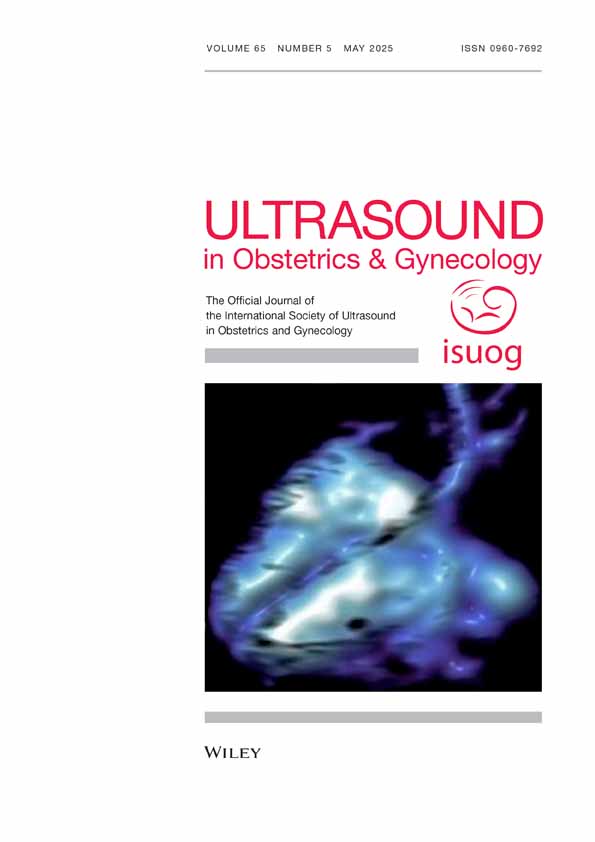Fetal loss following ultrasound diagnosis of a live fetus at 6–10 weeks of gestation
Abstract
Objective
To examine prospectively the value of demographic characteristics and ultrasound findings in the prediction of subsequent fetal loss in pregnancies with live fetuses at 6–10 weeks of gestation.
Methods
Transvaginal ultrasound examination was performed in 866 pregnancies at 6–10 weeks of gestation. The relation of demographic data and ultrasound findings at the time of the initial assessment to subsequent fetal loss was examined.
Results
In the 668 singleton pregnancies with live fetuses and complete follow-up there were 50 (7.5%) fetal losses. The incidence of fetal loss increased significantly with maternal age and decreased with gestation. In the pregnancies resulting in fetal loss, compared to those with live births, the incidence of vaginal bleeding and cigarette smoking was higher, the fetal heart rate was significantly lower and the gestation sac diameter was smaller but the yolk sac diameter was not significantly different.
Conclusion
In pregnancies with a live fetus at 6–10 weeks' gestation the rate of subsequent fetal loss is related to maternal age, gestation, cigarette smoking, history of vaginal bleeding and the ultrasound findings of small gestation sac diameter and fetal bradycardia, relative to crown–rump length. Copyright © 2003 ISUOG. Published by John Wiley & Sons, Ltd.
Introduction
Miscarriage, which affects about 10–15% of clinically recognized conceptions, is the commonest complication of pregnancy1. Numerous studies have examined the potential value of demographic characteristics and various ultrasonographic parameters in the prediction of those pregnancies that will miscarry2-29. These studies have reported an association between increased risk for miscarriage and advanced maternal age, previous history of miscarriage, vaginal bleeding, fetal bradycardia, early-onset fetal growth restriction, small gestational sac volume and large yolk sac. However, most of these studies included small numbers of patients, were retrospective or were carried out in highly selected populations, including women presenting with vaginal bleeding or abdominal pain and in pregnancies achieved using assisted reproduction techniques.
The aim of this study was to prospectively evaluate in an unselected population the efficiency of demographic characteristics and ultrasound parameters in early pregnancy in the prediction of subsequent fetal loss.
Methods
In Ioannina University Hospital, Greece, all pregnant women are offered routine ultrasound examination at 6–10 weeks of gestation for determination of viability, confirmation of gestation and diagnosis of ectopic and multiple pregnancies. This study reports the findings of the early transvaginal ultrasound scan in 866 pregnancies at 6–10 weeks of gestation that were seen consecutively. We examined the possible relation between fetal loss and both demographic data and ultrasonographic findings.
Demographic data and ultrasound findings were recorded in a computer database at the time of the ultrasound examination. Pregnancy outcome was obtained from the hospital notes, and in those women who delivered in other units from the obstetricians or the patients themselves; these data were recorded in the database retrospectively. The demographic data recorded included maternal age, cigarette smoking, previous obstetric history, menstrual cycle and date of last menstrual period (LMP), if the conception was spontaneous or assisted and bleeding during the current pregnancy.
Ultrasound scans were carried out transvaginally using a 5-MHz transducer (Toshiba SSA 220A, Tokyo, Japan). All scans were performed by G.M. who has extensive experience in early first-trimester scans, or by trainee obstetricians under his supervision. In each case, a thorough examination was performed to determine if the pregnancy was intrauterine, to identify the yolk sac and fetal pole and to measure the gestational sac and yolk sac diameters, fetal crown–rump length (CRL) and fetal heart rate (FHR) (this was measured only in the last 516 of the 668 cases). The CRL was measured as the greatest length of the fetus or embryo and the FHR was recorded using the M-mode of the ultrasound machine. The mean yolk sac diameter and the mean gestational sac diameter were calculated by dividing the three perpendicular diameters. Gestational age was calculated from the fetal CRL. The diagnosis of a miscarriage was made if in the presence of a fetal pole > 10 mm there was no fetal heart activity or if the gestational sac diameter was > 25 mm but no fetal pole could be demonstrated. In cases with an empty gestational sac < 25 mm in diameter, a repeat scan was carried out 1–2 weeks later30.
Statistical analysis
Mann–Whitney U-test was used to compare the demographic characteristics of pregnancies resulting in live births with those ending in fetal loss. In those pregnancies resulting in live births, regression analysis was carried out to determine the best-fit line describing the association between fetal CRL and gestational sac mean diameter, yolk sac mean diameter and FHR. The individual measured values in both the pregnancies resulting in live births and in those ending in fetal death were expressed as differences from the appropriate normal mean for CRL (delta values). Mann–Whitney U-test was used to determine the significance of differences between these groups. Multiple regression analysis was used to determine the demographic characteristics and ultrasound findings that provided a significant independent contribution in explaining the rate of fetal loss.
Results
An early scan was carried out in 866 pregnancies. At the first scan there was a singleton intrauterine pregnancy with a live fetus in 724 cases, a twin pregnancy in 13, an incomplete miscarriage in 34, a miscarriage in 30, an ectopic pregnancy in four, a molar pregnancy in two and in 59 cases there was an empty gestational sac < 25 mm in diameter. In the latter group repeat ultrasound examination 1–2 weeks later demonstrated a live fetus in 44 cases and a miscarriage in 15. In the 768 singleton pregnancies with live fetuses at the first or second scan, 69 were uncertain of the date of their LMP, 13 had terminations (six for psychosocial reasons and seven for fetal abnormalities) and 18 were lost to follow-up. In the remaining 668 pregnancies, 618 resulted in live births and 50 (7.5%) in miscarriages or intrauterine deaths. The gestation at fetal loss was < 15 weeks in 45 cases, 20–30 weeks in four and 38 weeks in one.
In the 668 pregnancies with live births or fetal losses, the median maternal age was 27 (range, 17–45) years. The incidence of fetal loss increased significantly with maternal age and decreased with gestational age at initial ultrasound examination (Table 1). In the pregnancies resulting in fetal loss compared to those with live births, the incidence of vaginal bleeding and cigarette smoking was higher (Table 2), but there was no significant difference in the rate of spontaneous conception (compared to in vitro fertilization) or previous obstetric history (percentage of primigravidae, percentage of those who had only had previous miscarriages and percentage of those who had previous live births).
| Parameter | Fetal loss (%) | Statistical analysis |
|---|---|---|
| Gestation (weeks) | ||
| 6 | 18/175 (10.3) | χ2 for trend |
| 7 | 17/215 (7.9) | χ2 = 4.16, P = 0.04 |
| 8 | 11/148 (7.4) | |
| 9 | 4/130 (3.1) | |
| Maternal age (years) | ||
| < 20 | 1/23 (4.4) | χ2 = 7.74, P = 0.005 |
| 20–35 | 40/597 (6.7) | |
| > 35 | 9/48 (18.8) | |
| Variable | Live birth (n = 618) | Fetal loss (n = 50) | Statistical analysis |
|---|---|---|---|
| Smoking | 54 (8.7) | 9 (18.0) | Z = − 2.2, P = 0.03 |
| RR 2.04 (1.06–3.72) | |||
| Assisted reproduction | 24 (3.9) | 3 (6.0) | Z = − 0.7, P = 0.46 |
| Primiparous | 287 (46.4) | 24 (48.0) | Z = − 0.21, P = 0.83 |
| Previous fetal loss | 62 (10.0) | 3 (6.0) | Z = 0.93, P = 0.73 |
| Previous live birth | 269 (43.5) | 23 (46) | Z = − 0.34, P = 0.73 |
| Vaginal bleeding | 38 (6.2) | 8 (16.0) | Z = − 2.65, P = 0.008 |
| RR 2.6 (1.27–5.03) | |||
| Maternal age (years) | 26 (17–45) | 27 (18–40) | t = 1.13, P = 0.26 |
| Gestation (weeks) | 7.6 (6–10) | 7.3 (6–9.8) | t = − 1.82, P = 0.07 |
| Crown–rump length (mm) | 10 (1–39) | 9.3 (2–23) | t = − 4.52, P < 0.0001 |
| Fetal heart rate (bpm) | 150 (77–191) | 116 (99–197) | t = − 4.85, P < 0.0001 |
| Gestation sac diameter (mm) | 23 (5–54) | 15 (11–38) | t = − 5.64, P < 0.0001 |
| Yolk sac diameter (mm) | 5 (1–22) | 4.7 (2–10) | t = − 1.9, P = 0.06 |
| Yolk sac : gestation sac ratio | 4.6 (1–11.1) | 3.2 (1.4–7.8) | t = − 5.14, P < 0.0001 |
- RR, relative risk.
In the pregnancies that resulted in live births there was a significant association between CRL and FHR (Figure 1; FHR = 96.2 + 6.35 CRL—0.125 CRL2, r = 0.86, P < 0.001), mean gestational sac diameter (Figure 2; gestational sac diameter = 12.87 + 0.905 CRL, r = 0.86, P < 0.001) and mean yolk sac diameter (Figure 3; yolk sac diameter = 4.3 + 0.071 CRL, r = 0.45, P < 0.001).

Relationship between fetal heart rate (FHR) and fetal crown–rump length (CRL) in 516 consecutive unselected pregnancies. Cases resulting in live birth (□) or subsequent fetal loss (▵). The lines represent the mean, 5th and 95th centiles of the normal range for gestation.

Relationship between mean gestation sac (GS) diameter and fetal crown–rump length (CRL) in 668 consecutive unselected pregnancies. Cases resulting in live birth (□) or subsequent fetal loss (▴). The lines represent the mean, 5th and 95th centiles of the normal range for gestation.

Relationship between mean yolk sac (YS) diameter and fetal crown–rump length (CRL) in 668 consecutive unselected pregnancies. Cases resulting in live birth (□) or subsequent fetal loss (▴). The lines represent the mean, 5th and 95th centiles of the normal range for gestation.
In the cases that subsequently resulted in pregnancy loss, FHR for CRL was significantly lower than normal (median difference = − 0.87 SDs, t = − 4.6, P < 0.001; Figure 1), the gestation sac diameter was smaller (median difference = − 0.47 SDs, t = − 4.24, P < 0.001; Figure 2), but the yolk sac diameter was not significantly different (median difference = − 0.07 SDs, t = − 0.5, P = 0.62; Figure 3).
Multiple regression analysis demonstrated that significant independent contributions in explaining the rate of fetal loss were provided by gestation sac diameter (t = 5.92, P < 0.001), FHR (t = 3.26, P < 0.001), history of vaginal bleeding (t = 2.53, P = 0.01) and gestational age (t = 2.52, P < 0.05). There was no significant independent contribution from the other demographic or sonographic features examined. In the subgroup of cases with CRL ≤ 10 mm (n = 349), the strength of association with gestation sac size was increased (P < 0.0001), but no additional factors were statistically significant in this group. There were no significant differences in ultrasound parameters between those cases in which fetal loss occurred within 2 weeks of the scan compared to cases in which the loss occurred after a longer interval. However, in all four cases in which the yolk sac diameter was above the 95th centile in which fetal loss occurred (Figure 3), the pregnancy failed within 10 days of the ultrasound examination, suggesting that marked yolk sac enlargement may be a preterminal event in some cases, although the majority of pregnancies in which fetal loss occurred within 2 weeks of the scan did not have yolk sac enlargement or any other specific feature compared to those miscarrying after this interval.
Discussion
The findings of this study demonstrate that the incidence of fetal loss increases with maternal age, from about 4% for those aged less than 20 years to about 20% for those aged more than 35 years, decreases with gestation from about 10% for those with live fetuses at 6 weeks to about 3% at 10 weeks, and is 2.6 times higher in women with a history of vaginal bleeding in pregnancy compared to those with no bleeding. The important ultrasound findings in pregnancies that subsequently resulted in fetal loss, compared to those resulting in live births, were a small gestational sac diameter and fetal bradycardia.
The exponential increase in the rate of fetal loss with maternal age is compatible with the findings of previous reports. Thus, in a study of 2139 women presenting before 10 weeks of gestation, the miscarriage rate after confirmation of fetal viability was about 2% for those aged less than 40 years and about 14% in those who were 40 years or older24. Similarly, a study of 201 pregnancies achieved after ovulation induction and demonstration of fetal cardiac activity at 7–9 weeks of gestation reported that the rate of subsequent fetal loss increased from 2.1% for women aged 35 years or less, to 14.9% for those aged 36–39 years and 20% for those over 40 years3. The majority of pregnancies resulting in early fetal loss are chromosomally abnormal31, 32, and the well-reported exponential increase in risk for fetal trisomy with increasing maternal age is the most likely explanation for the association. Similarly, the inverse relationship between gestational age and fetal loss rate is consistent with the results of previous studies and may also be a consequence of the high early lethality of chromosomally abnormal embryos33. For example, a previous study of 6337 pregnancies reported an inverse correlation between gestation and rate of subsequent fetal loss, which decreased by about 1% per week from 9.6% at 7 weeks to 2.3 at 14 weeks22.
Vaginal bleeding is an early feature of miscarriage and inevitably the rate of fetal loss was higher in those women with bleeding compared to those without. It was previously reported that in about 20% of pregnancies there is early vaginal bleeding. In these women with early bleeding ultrasound examination demonstrates a non-viable pregnancy in 40% of cases and in those with a live fetus subsequent fetal loss occurs in about 10%6.
Similar to our findings, previous studies have shown a strong association between small gestation sac and subsequent fetal loss4, 14, 16, 17. For example, Cunningham et al.4 performed ultrasound scans every week from 5 to 12 weeks in 40 high-risk pregnancies and reported that the 20 which subsequently miscarried had a smaller gestational sac from as early as the fifth week and the rate of increase in gestational sac was also significantly lower than in those with a normal outcome. A small gestation sac diameter in early pregnancy may be the consequence of small amniotic cavity or celomic cavity or both. However, neither the present nor the previous studies have examined this issue. In the second half of pregnancy oligohydramnios is essentially the consequence of impaired placental perfusion, urinary tract abnormality or amniorrhexis. The extent to which an early decrease in gestational sac and the association with subsequent fetal loss are the consequence of impaired placentation remains to be determined.
FHR has been studied extensively and numerous studies have demonstrated a strong association between pathological FHR and fetal loss. Fetal bradycardia is a sign of impending fetal death reflecting the forthcoming collapse of the cardiovascular system. Another possible cause for the high miscarriage rate in fetuses with abnormal FHR is that there may be an underlying chromosomal abnormality, such as trisomy 18 or triploidy, which is associated with fetal bradycardia34.
Previous studies have reported an association of abnormal yolk sac size with early fetal loss. For example, Kucuk et al.21, in a study of 250 pregnancies in the first trimester investigated, by transvaginal ultrasound, the potential value of yolk sac diameter in the prediction of adverse pregnancy outcome. They found that only 8/219 pregnancies that had a normal outcome had abnormal yolk sac size compared to 20/31 that subsequently miscarried. Another study of 486 pregnancies, examined prior to 10 weeks of gestation, reported that the yolk sac diameter was more than 2 SDs either above or below the normal mean for gestation in 27% of the 159 that subsequently miscarried, compared to 7% in those with normal outcome20. In the present study we did not find a significant association between abnormal yolk sac size and fetal loss. However, in all four cases in which the yolk sac diameter was above the 95th centile in whom fetal loss occurred the pregnancy failed within 10 days of the ultrasound examination, suggesting that marked yolk sac enlargement may be a preterminal event in some cases, although the majority of pregnancies in which fetal loss occurred within 2 weeks of the scan did not have yolk sac enlargement or any other specific feature compared to those miscarrying after this interval.
In pregnancies with a live fetus at 6–10 weeks' gestation the rate of subsequent fetal loss is related to maternal age, gestation, cigarette smoking, history of vaginal bleeding and the ultrasound findings of small gestation sac diameter and fetal bradycardia.





